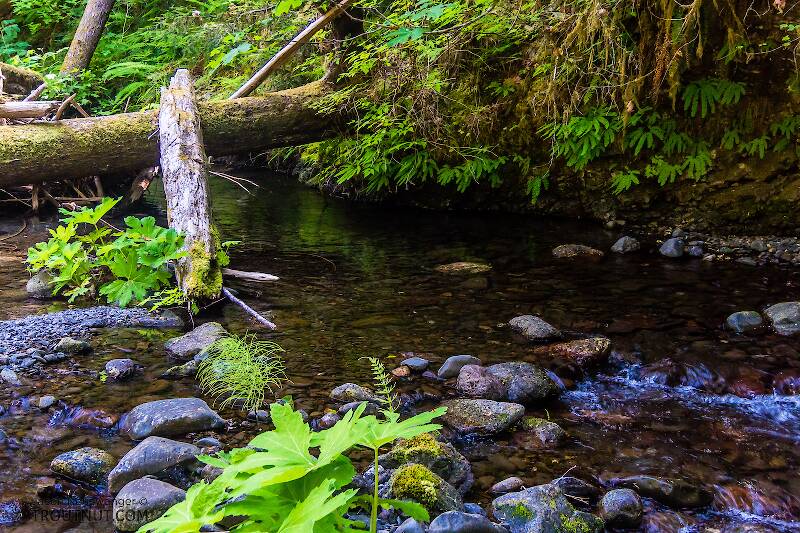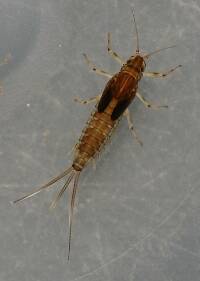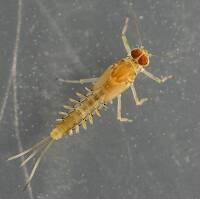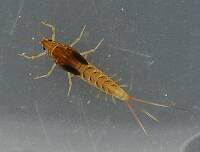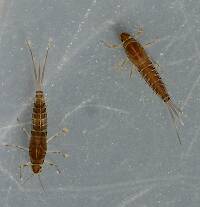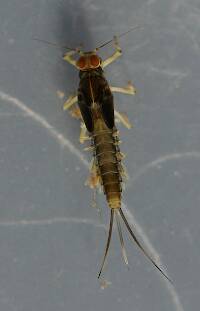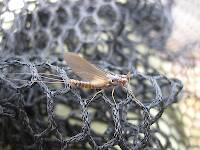
Blue-winged Olives
Baetis
Tiny Baetis mayflies are perhaps the most commonly encountered and imitated by anglers on all American trout streams due to their great abundance, widespread distribution, and trout-friendly emergence habits.
Featured on the forum

Troutnut is a project started in 2003 by salmonid ecologist Jason "Troutnut" Neuswanger to help anglers and
fly tyers unabashedly embrace the entomological side of the sport. Learn more about Troutnut or
support the project for an enhanced experience here.
Millcreek on Nov 25, 2015November 25th, 2015, 7:21 am EST
Over the last week the Fallceon species have been emerging and mating. It usually begins by late morning or early afternoon when the males take up position over the water and a certain distance inland. They bob up and down over water and inland from a few inches to well over 10 ft above the water or land. They appear to all be imagos.
The females show up after the males and appear to be all subimagos. It would appear they are mated while they are still subimagos. They come off the water and are immediately mobbed by the males with one male appearing to mate with the female while other males swarm around it. The females appear as imagos later in the day after the males have disappeared for the day. The female imagos appear to lay eggs.
My question is: Do many male mayflies mate with subimagos? Has anybody else seen this happening?
The females show up after the males and appear to be all subimagos. It would appear they are mated while they are still subimagos. They come off the water and are immediately mobbed by the males with one male appearing to mate with the female while other males swarm around it. The females appear as imagos later in the day after the males have disappeared for the day. The female imagos appear to lay eggs.
My question is: Do many male mayflies mate with subimagos? Has anybody else seen this happening?
"If we knew what it was we were doing, it would not be called research, would it?"
-Albert Einstein
-Albert Einstein
Martinlf on Nov 25, 2015November 25th, 2015, 6:08 pm EST
I believe I've seen it with eastern green drakes. Not with a lot of bugs, but a select few. I asked Gonzo about this and he said that when the hormones begin to flow, bugs sometimes exhibit the same kind of behavior drunk frat boys do. And drunk non-frat boys. I believe in humans this kind of indiscriminate urge to mate under the influence is sometimes called beer goggles. I don't know how long the sperm remains viable in bugs. It can last a while in humans; I wonder if any of the bug guys know whether or not subimagos can be fertilized.
"He spread them a yard and a half. 'And every one that got away is this big.'"
--Fred Chappell
--Fred Chappell
PaulRoberts on Nov 30, 2015November 30th, 2015, 5:54 am EST
Good question. I've ever seen that.
Millcreek on Nov 30, 2015November 30th, 2015, 6:53 am EST
Louis,
What is either the scientific or more specific name for the eastern green drakes? I tried googling it and came up with several hits.
The Fallceon quilleri I've seen seem to engage in this behavior most of the time. I've never seen a female imago being mated. I'm not saying it never happens but if it does it happens at a time when I don't see it.
Paul,
I haven't seen it in any other species so far, but I'll be watching a little more closely now. There is a paper which gives some indication that fertilization can occur in subimagos.
The paper is "The Mayfly Subimago" by George Edmunds, Jr. and W.P. McCafferty(1988). It can be seen here:
http://www.ephemeroptera-galactica.com/pubs/pub_e/pubedmundsg1988p509.pdf
What is either the scientific or more specific name for the eastern green drakes? I tried googling it and came up with several hits.
The Fallceon quilleri I've seen seem to engage in this behavior most of the time. I've never seen a female imago being mated. I'm not saying it never happens but if it does it happens at a time when I don't see it.
Paul,
I haven't seen it in any other species so far, but I'll be watching a little more closely now. There is a paper which gives some indication that fertilization can occur in subimagos.
The paper is "The Mayfly Subimago" by George Edmunds, Jr. and W.P. McCafferty(1988). It can be seen here:
http://www.ephemeroptera-galactica.com/pubs/pub_e/pubedmundsg1988p509.pdf
"If we knew what it was we were doing, it would not be called research, would it?"
-Albert Einstein
-Albert Einstein
PaulRoberts on Dec 1, 2015December 1st, 2015, 6:22 am EST
Thanks, Mark.
Millcreek on Dec 1, 2015December 1st, 2015, 6:54 am EST
I've also run across an article that states that the mayfly, Dolania americana only mates when the female is a subimago, in fact the females remain subimagos for the rest of their lives.
The article is here:https://www.dnr.sc.gov/cwcs/pdf/Mayfly.pdf
It also occurs in Ephoron sp. Article is here:
http://www.ephemeroptera-galactica.com/pubs/pub_g/pubgibersond1985p1668.pdf
The article is here:https://www.dnr.sc.gov/cwcs/pdf/Mayfly.pdf
It also occurs in Ephoron sp. Article is here:
http://www.ephemeroptera-galactica.com/pubs/pub_g/pubgibersond1985p1668.pdf
"If we knew what it was we were doing, it would not be called research, would it?"
-Albert Einstein
-Albert Einstein
Martinlf on Dec 1, 2015December 1st, 2015, 10:07 am EST
Here's the Eastern Green Drake, Mark. What a bug! The spinners look like bombers overhead, and their weaving and dipping flight is stunning to behold. For years I believed those who said that fishing during the hatch is pointless--too many fishermen, too many bugs, picky fish that wouldn't eat them anyway, etc. Yes, it is a party for all involved, even a zoo, but now I wouldn't miss it for anything. I've met some great guys sitting on the bank waiting for the spinner fall, and if you catch the nymphing right the results can be phenomenal. Also look to the right on the banner page of Troutnut for a drake.
http://www.troutnut.com/hatch/494/Mayfly-Ephemera-guttulata-Green-Drake
P.S. Your link above on Dolania is no longer working, but the other articles are interesting. As I noted above, when I saw this with Green Drakes, I wondered. Nature is certainly full of mysteries and surprises.
http://www.troutnut.com/hatch/494/Mayfly-Ephemera-guttulata-Green-Drake
P.S. Your link above on Dolania is no longer working, but the other articles are interesting. As I noted above, when I saw this with Green Drakes, I wondered. Nature is certainly full of mysteries and surprises.
"He spread them a yard and a half. 'And every one that got away is this big.'"
--Fred Chappell
--Fred Chappell
Millcreek on Dec 1, 2015December 1st, 2015, 12:05 pm EST
Thank you, Louis.
The link on Dolania works on my computer. Don't know why it doesn't on yours. Thanks for the reply on the Green Drakes. Nature is certainly full of mysteries and surprises, I get kicked in the ass every time I get complacent.
P.S. Your link above on Dolania is no longer working, but the other articles are interesting. As I noted above, when I saw this with Green Drakes, I wondered. Nature is certainly full of mysteries and surprises.
The link on Dolania works on my computer. Don't know why it doesn't on yours. Thanks for the reply on the Green Drakes. Nature is certainly full of mysteries and surprises, I get kicked in the ass every time I get complacent.
"If we knew what it was we were doing, it would not be called research, would it?"
-Albert Einstein
-Albert Einstein
Quick Reply
Related Discussions
Topic
Replies
Last Reply
3
Dec 10, 2015
by PaulRoberts
by PaulRoberts
1
Sep 9, 2008
by GONZO
by GONZO
2
Jul 9, 2018
by Martinlf
by Martinlf
1
Oct 24, 2006
by Troutnut
by Troutnut

